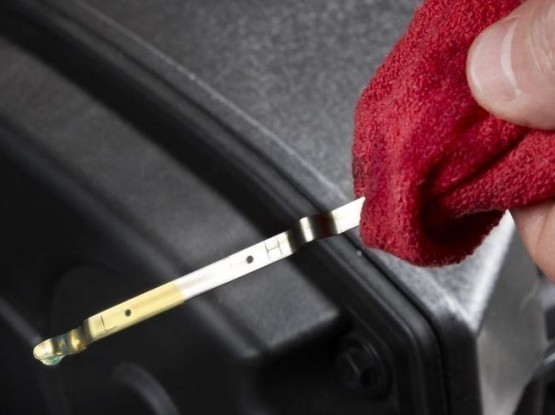You won’t hurt your engine by adding oil when it’s hot, but you’ll increase your own risk of getting burned by dripped or splattered oil, and of breathing in acrid smoke. You’ll also get a less accurate reading of your engine’s true oil levels when it’s hot.
The bottom line: If necessary, you can change your oil when it’s hot but wait 10-15 minutes if you can. That’s enough time to let your engine’s oil cool down and for you to get a true sense of how much is present in your engine.
That’s the quick answer. The devil is sometimes in the details, so read on to learn more!
What Does Oil Do For Your Engine?
Oil protects your engine’s hardest-working parts, from its pistons to its rocker arms and drive shaft. You don’t need to know how each of those parts works, just that they’re built to fire and turn so fast, for so long, that they need a bit of a break.
Think about the pistons that fire up and down in your engine’s cylinders. Typically made of aluminum alloy or low-carbon steel, they’re built to fit precisely and to weigh as little as possible. Without some sort of lubricant, these parts would create so much friction that they’d quickly overheat and warp out of shape. And that would be the end of your engine.
Oil keeps those parts slick, which keeps friction and heat down. In the process, it gets heated up, too—oil literally absorbs heat from your engine’s components. That’s an important reason why we recommend that you let a hot engine cool down before adding oil, and it deserves a bit of explanation.
How Does Your Engine’s Temperature Affect its Oil?
As it absorbs heat, oil loses viscosity: it gets thinner. Think of the difference between pouring maple syrup on a hot day and waiting for it when your kitchen is cold. As long as you keep up with your oil changes and always use the oil weight that’s right for your vehicle, your engine will still be protected, even when your oil is thinned out a bit from heat.
As it thins, motor oil—especially synthetic oil—expands just a bit. That’s another reason to wait until your engine has cooled down: you simply can’t get an accurate reading of oil that’s temporarily taking up more volume than usual. Without a little patience, you could wind up thinking that you’ve topped up your oil while still leaving it short of the mark.
We should add that cold-weather drivers face the same problem in reverse. Oil that’s been standing in freezing temperatures for a while can be thicker than usual, and it can contract a bit. To get an accurate reading of your oil levels, be sure to run your engine for 15 minutes or so, then let it cool off for a minute before measuring and adding oil.
How Long Should Your Engine Cool Down Before You Add Oil?
It’s typically best to let your engine cool down for 10-15 minutes before reaching for the dipstick. That’s enough time to ensure that any oil that might drip or splatter while you’re measuring your levels won’t burn your skin, and for your oil to return to its normal volume. It also lets the oil that’s been circulating throughout your engine settle back down and return to the oil reservoir, giving you an accurate idea of where things stand.
How do You Know When it’s Time to Add or Change Your Oil?
Oil does more than protect your engine: it traps tiny bits of dirt and dust and hangs onto them. Dirty oil is less effective than clean oil, and it can introduce contaminants that hurt your engine’s components. That’s why you need to change it regularly.
Even properly changed oil can run low at times. Your vehicle’s engine depends on a certain amount of oil at all times, so check your owner’s manual to see exactly where your oil level needs to be…and keep it there. Here’s how.
How to Check Your Oil Level
- Park on a level surface. It’s hard to tell how much water is in a cup that’s tipped to one side, and it’s hard to tell how much oil is in a vehicle parked on a hill.
- Give your engine 10-15 minutes to cool down. While you’re waiting, find a cloth or a clean rag. In a pinch, you can use a paper towel.
- Pop open the hood. Your dipstick rests inside the oil reservoir, but it should have a bright plastic tab (typically yellow, red, or orange) that makes it easy to spot and remove.
- Grip the tab and remove the dipstick. Wipe it clean with the cloth or rag, making sure to remove all residue (this can be a bit trickier with a paper towel).
- Return the dipstick to the reservoir, making sure to push it all the way down. The tab should tell you when it’s set. Wait a few seconds and slowly remove the dipstick again.
- Look at where the oil has clung to the dipstick, and measure it against the minimum and maximum lines etched into the stick. That’s your sweet spot. Never, ever exceed your engine’s maximum oil level.
How to Add Motor Oil
To avoid going over your vehicle’s maximum oil level, you’ll need to add new oil somewhat carefully. If your oil level is below your dipstick’s minimum line, remove the oil cap and add just a bit to your engine. Check your oil level again to see how much it’s changed. Repeat the process until your oil is where it should be.
When to Change Your Oil
Today’s passenger cars are highly efficient, and can go 5,000‑7,000 miles between oil changes. Most vehicles these days do a good job of monitoring their own oil levels, and will alert you with an indicator on your dashboard when oil levels are running low. Some even alert you to the need for an oil change based on your mileage. As with most things automotive, you should check your vehicle’s manual for more information.
How to Change Your Oil Safely
Changing your vehicle’s oil is straightforward. Changing it safely and tidily takes a bit of preparation and attention to detail. Here are a few tips that will keep you safe and keep your cleanup to a minimum.
- Let your engine cool down for 10-15 minutes before changing its oil.
- By the same token, warm up a freezing-cold engine for a few minutes before reading its oil level.
- Wear rubber gloves when you change your oil, and have a few rags or shop towels nearby.
- If it’s your first time, or if you just feel like being extra-safe, consider using a tarp (or an old shower curtain) to protect everything under your vehicle.
- Use a drain pan to catch the old oil.
- If the drain plug pops out before you can grab it, don’t reach into the drain pan right away! You might burn your hand, even if you’re wearing gloves. And you’ll need to wait a few minutes for all the oil to drain, anyway.
- Before you add a new oil filter, be sure to spread a little clean oil around its gasket. Dry seals fail quickly.
- Always use the type and weight of oil recommended by your vehicle’s manufacturer.
- Use a funnel to make accurate pouring easier. Just be sure to take it slow: oil is thick enough to overflow a funnel if you try to pour it all in at once.
- Always respect your engine’s maximum oil level. When you get close to what you think is the right amount of new oil, start checking your levels regularly.
- Don’t forget that drain plug! And don’t screw it on too tightly; about 25 pounds of torque will do it. Overtightening your drain plug might cause it to leak.
- Empty the drain pan into a bottle or other appropriate container, and dispose of old oil responsibly.


